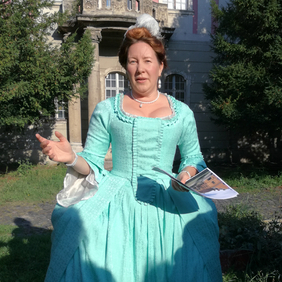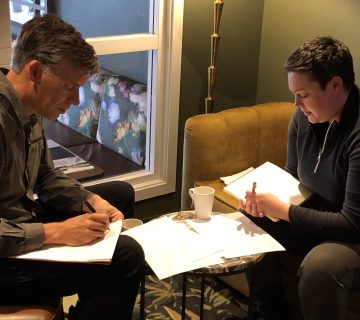Interpret Europe’s new Certified Live Interpreter (CLI) course was tested in collaboration with the UK company, Past Pleasures, otherwise in charge of training staff at the British Royal Palaces. The setting for the course was more than suitable, as the lectures and practicals took place in the Hungarian Museum of Trade and Tourism. If I had to name just one thing that everyone present had in common, it would be their love of interpreting history. According to studies, people only remember 20% of what they hear, but 80% of what they experience. If the experience is through interpretation of a specific person from the past and this is done in the right and authentic way, then the whole experience becomes even more memorable.
The programme for certification lasted one week, during which there was some time to prepare for the final exam. The course covered many different subjects, including what a costume is and what is expected from a person wearing one. What kind of theoretical ‘hats’ there are and which ones the person doing the interpretation must wear to get the right message across to the guests. Various difficult situations were also presented to the participants, and everyone was able to learn from each other.
A very important part of live interpretation is a thorough preparation of the character. Once the life circle of that person is set, one can start going into details, and thus learn the various customs from the past up to the present, including how to behave authentically and to practice the correct form of curtsy upon greeting people.
A specially designed toolkit is needed for delivering live interpretation and thus the various techniques were also presented and practised. All the theory was supported by real cases, when live interpretation was presented in first, second and third person and that helped greatly with the development of the final assessment.
The pilot Certified Live Interpreter training course was completed when each of the attendees chose, prepared and presented a character according to strict standards that included ten different categories of evaluation. The end of course exam was also useful in that the valuable feedback can be implemented to improve our future work. During the course, we also had some great time learning about 17th century fencing and sword fighting. But that was just a moment of inspiration.
As Penny Wilkinson said: ‘It is impossible to re-enact the past, but we can research and interpret as we can.’ I think we have managed to learn and master the art of live interpretation and shall be happy to share the newly gained knowledge with others as well.
Tina Hudnik is a co-founder of G-Guides, a school for responsible tourist guides, and is also the main organiser of the Green Microphone Award – the voice of responsible tourism, which is an international award for tourist guides. You can get in touch with her at: tina.hudnik@gmail.com.
To cite this article:
Hudnik, Tina (2018) ‘Playing the past: Certified Live Interpreter pilot training course’. In Interpret Europe Newsletter 3-2018, 13.
Available online:
www.interpret-europe.net/fileadmin/Documents/publications/Newsletters/ie-newsletter_2018-3_autumn.pdf




